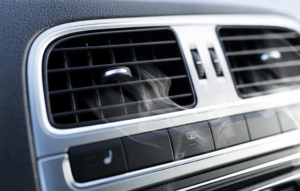Tesla vehicles have rapidly become synonymous with innovation, sustainability, and the future of transportation. With their sleek designs, cutting-edge technology, and eco-friendly appeal, it’s no wonder they have captured the hearts of consumers worldwide. However, as more people embrace these electric marvels, some concerns about potential health risks have started to surface.
Recently, a growing number of Tesla owners have reported experiencing various health issues that seem to be linked to their vehicles. Two primary concerns stand out: exposure to electromagnetic fields (EMFs) and mold contamination.
In this blog, we will take a look at the unsettling experiences of one of these Tesla owners, Elle, who suffered from a range of pretty serious symptoms while driving her car. We will explore the science behind EMF exposure and mold growth in electric vehicles and provide practical steps for mitigating these risks. Whether you’re a current Tesla owner or are considering making the switch, understanding these potential health hazards is essential so that you can protect your well-being.
Elle’s Story
Elle, a content creator known as @livingwellwithelle on Instagram, purchased her Tesla in 2021, hoping to embrace the benefits of electric driving. However, her experience turned out to be far from the seamless and healthy lifestyle she set out for. Over the course of two and a half years, Elle began to notice a disturbing array of symptoms that seemed inexplicably tied to her time spent in her Tesla.
Timeline of Symptoms
Initially, Elle experienced extreme fatigue. What started as occasional tiredness after long drives soon escalated to the point where even a simple trip to the grocery store left her exhausted. She would return home and need to rest for 20 minutes before unloading her car, even after just two hours on the road.
As time went on, Elle’s symptoms grew more severe. A year into owning the car, she developed persistent neck and shoulder pain. The design of the Tesla’s headrest, which she claims forced her into an uncomfortable forward neck posture, likely exacerbated these issues.
Soon after though, she began to experience nosebleeds, a symptom she had never dealt with before. Although she initially attributed this to environmental factors like weather and controlled burns, the nosebleeds ceased once she sold the car. Towards the end of her ownership, Elle was even experiencing nausea and, alarmingly, hair loss.
Realization and Resolution
It wasn’t until Elle took several long road trips with her mother in a regular car and felt perfectly fine that she began to suspect her Tesla was the source of her ailments. Despite initially blaming other factors, it became clear that her health issues were linked to her vehicle.
After selling the Tesla, Elle’s symptoms disappeared. After documenting her experience on social media and discussing her issues with her followers, she believes mold contamination may have been a hidden culprit. Comments on her posts revealed that she wasn’t alone; dozens of other Tesla owners shared similar experiences of illness that they suspected was caused by mold in their cars.
The EMF Problem
Electromagnetic fields (EMFs) are invisible areas of energy produced by electrically charged objects. These fields are present in all electric devices, including electric vehicles like Teslas. While EMFs are a natural part of our environment, there is growing concern about the health effects of prolonged exposure, especially at higher levels.
charged objects. These fields are present in all electric devices, including electric vehicles like Teslas. While EMFs are a natural part of our environment, there is growing concern about the health effects of prolonged exposure, especially at higher levels.
EMFs in Teslas
Electric vehicles, including Teslas, generate EMFs from their batteries, motors, and electronic systems. While Teslas are lauded for their advanced technology and environmental benefits, there is growing concern about the potential health risks associated with prolonged exposure to these fields. Some studies have suggested that high levels of EMF exposure could contribute to a range of health issues, from headaches and fatigue to more severe neurological and reproductive problems.
Elle’s Experience and EMFs
Elle’s symptoms, including extreme fatigue and nausea, could potentially be linked to prolonged EMF exposure from her Tesla – the symptoms certainly line up. Her realization that she felt significantly better during long road trips in conventional cars further supports the theory that her health issues were related to her electric vehicle.
While concrete scientific evidence directly linking EMF exposure from Teslas to specific health problems is still emerging, Elle’s case and similar anecdotal reports from other Tesla owners suggest that this is an area worthy of further investigation. For those experiencing unexplained health issues, considering the potential impact of EMFs might be a valuable step.
The Mold Problem
Mold is a type of fungus that thrives in damp, humid environments. It can grow on almost any surface, especially in areas where moisture accumulates. In vehicles, mold growth can occur due to leaks, condensation, and the build-up of moisture within the air conditioning system and cabin air filter area. Electric vehicles like Teslas may be particularly susceptible to these conditions due to their complex and enclosed electronic systems, but all cars and trucks are susceptible as well.
Health Risks of Mold
Exposure to mold can lead to a variety of health issues, particularly respiratory problems, allergies, and skin irritation. Mold spores can trigger asthma attacks, sinus congestion, and other respiratory symptoms. Prolonged exposure can also result in more severe health problems, such as chronic respiratory illnesses, systemic infections, and neurological issues like headaches and fatigue
Elle’s Experience and Mold
Elle’s discovery that her Tesla might have been contaminated with hidden mold offers a plausible explanation for many of her symptoms. Her extreme fatigue, nosebleeds, nausea, and hair loss are consistent with mold toxicity.
Elle’s case is not unique. Dozens of people have shared similar experiences of feeling unwell after being in a Tesla. For instance, one person reported their sister and brother-in-law’s vehicle was found to have mold everywhere after being sent in for repairs. Another individual on Reddit shared a video of their Tesla’s interior covered in mold after being left in a garage for a month.

These accounts suggest that mold growth might occur in electric vehicles due to moisture build-up in the air conditioning system and cabin air filter area. While it is unclear if this issue affects all Tesla models, it underscores the need for vigilance and regular maintenance to prevent mold contamination.
Broader Implications
The potential health risks associated with EMF exposure and mold contamination in Teslas are significant concerns for both current and prospective Tesla owners. These issues highlight the need for increased awareness and proactive measures to ensure the safety and well-being of those who drive these new vehicles.
While the evidence is still emerging, the experiences of Elle and others indicate that these problems may be more common than previously thought. Tesla owners must stay informed about these potential hazards and take steps to protect their health.
Steps for Mitigation
Reducing EMF Exposure
- Limit Time in the Car: Minimize the duration of continuous driving to reduce prolonged exposure to EMFs.
- Use EMF Protection: Consider using EMF protection products to reduce the harmful effects of EMF exposure within the vehicle – Aires Tech is the best bet for this sort of thing. Aires Tech’s Lifetune devices are designed to protect biologics (people and animals) from harmful electromagnetic fields. By integrating these innovative devices into your Tesla or just simply on your person, you can help mitigate the potential risks associated with EMF exposure.

Preventing Mold Growth
- Regular Maintenance: Ensure the air conditioning system and cabin air filter are regularly checked and cleaned.
- Use Dehumidifiers: Portable dehumidifiers can be used in the car to reduce moisture levels, particularly in humid climates.
- Inspect for Leaks: Regularly check for and promptly repair any leaks or sources of water intrusion in the vehicle.
By taking these proactive steps, Tesla owners can significantly reduce their risk of experiencing health issues related to EMF exposure and mold contamination. Awareness and preventative measures are key to ensuring a safe and healthy driving experience.
Conclusion
The potential health risks associated with Tesla vehicles, including EMF exposure and mold contamination, are significant concerns that should not be overlooked. The experiences of Elle and other Tesla owners highlight the importance of awareness and proactive measures to protect one’s health. 
By understanding the sources of these risks and taking steps to mitigate them, such as limiting EMF exposure and preventing mold growth, Tesla owners can ensure a safer driving experience. Utilizing products from Aires Tech can further enhance protection against these invisible threats.
Stay informed, take necessary precautions, and share your experiences to contribute to a safer and healthier community of Tesla owners.








